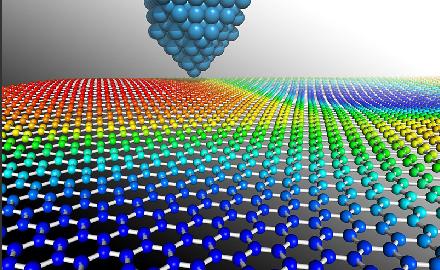Chemists at the University of Illinois claim this is possible, reporting that graphene becomes flexible to shape when a nanodroplet of water is added to it.

Graphene - a monoatomic layer of carbon, similar to those found in the tips of pencils - offers enormous potential for new types of nanodevices, if we manage to find a way to shape the material into the shapes we want.
Chemists from the University of Illinois claim that this is possible, reporting that graphene becomes flexible to shape when a nanodroplet of water is added to it.
"Until now, scientists were of the opinion that it was not possible to design these structures in a controllable way," said chemistry professor Petr Král. "However, we now know how to design graphene using the weak forces between nanodroplets carefully and precisely placed on graphene layers." The research findings were published in the scientific journal Nano Letters.
Engineers have already succeeded in shaping graphene into narrow strips and other shapes, expanding the family of carbon systems such as fullerenes, carbon nanotubes and nanodiamonds. Using computer simulations, the researchers showed that weak molecular interactions, known as "van der Waals forces", between water nanodroplets and the graphene layers can shape them into a multitude of shapes, without the graphene and water being chemically bonded.
"Depending on the size of the water droplet and the shape and size of the graphene layer that is used, we are able to shape the graphene into different shapes for a variety of applications," explains the lead researcher. "This is similar to the way proteins fold in biological cells with the help of chaperone proteins."
The research team showed that it is able to use a drop of water to roll, bend, slide and shape graphene into various complex structures such as rolls, sandwiches, loops and rings - all possible building blocks for making nanodevices with unique mechanical, electrical and optical properties. Through the use of special methods such as atomic force microscopy (AFM) and carefully oriented microscopic needles, it is possible to precisely place many drops of water and other materials on top of graphene to shape it into the desired shapes.
In the research laboratory, possible uses of nanoscale graphene are being tested, such as ways to coat it with phospholipids that will allow it to be part of biological cell membranes, where it can perform unique functions. Also, the researchers are preparing nanoporous graphene sheets that will enable the development of innovative molecular and ionic separation membranes for use in desalination and other applications.
Despite the fact that the materials used by the scientists are inorganic, the lead researcher identifies a growing trend in the development of hybrid multi-functional systems that combine inorganic nanostructures with cellular biological structures.
"Researchers are trying to discover signals that originate in the biological world or to transmit different signals to this world," he says. "In the future, proteins may be developed that can react with inorganic systems. It is a way of evolution to create an innovative interface, or a hybrid system, which works together to receive innovative functions."
The news from the university

One response
When I read the title for the first time it seemed to me like –
"Water droplets irritate graphene nanostructures"
: )